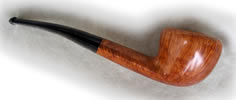No 315 - 25 July, 2013 Prestige Pipes Re-visited Last Friday afternoon we sold the Dunhill 2 Star, Straight Grain Bent Rhodesian (R13595.00).
|
Dunhill Bruyere; Group 4 Canadian (2011) 54-DHDPB4109Sil |
Savinelli Punto Oro Fume Kingsize 316 54-SavPOFumeK316 |
How can you resist?
However ……..
You may not yet be ready to add one of these to your collection.
So for you we have a consolation prize:
FREE - with any normal price pipe over the value of R395.00, |
You need it anyway – so that should be a very acceptable gift!
Colin Wesley
No.315 25 July – 7 August, 2013
You can read previous articles from "Across the Counter" in The Library.
No
316 -August 8, 2013 Make it go right! It sometimes happens like this: We go into the Humidor to look at some examples to illustrate what he’s been reading. Over time he returns for more cigars – and for help with problems he has experienced. “Sometimes I feel dizzy or even nauseous” - There are a couple of possible reasons: “I cannot keep the cigar burning, it keeps going out!” “The smoke is hot.” “I get a bitter taste.” “My cigars often burn unevenly.” This is most often the result of careless lighting up. “OK, this is obviously important – go over it again, what should I use to light my cigars?” The Turbo: A relatively recent (as these things go) development in the lighter field, it is akin to a blow torch and should be treated with the same respect. Watchpoint: Turbo mechanisms require extra-purified gas. Dunhill gas is highly refined, pure, Dunhill turbo-compatible butane gas. This ensures that valves are less likely to clog and malfunction, and the anti-corrosive properties protect all metal parts, thus considerably extending the life of all lighters. Dunhill Gas is the only gas in South Africa that is stamped “Turbo compatible”. A new 3-jet, flip-top model Turbo lighter has recently arrived on the market – well-priced at R270.00, effective, in two finishes, and with a built-in cigar punch:
A good time to invest in a Turbo lighter, but remember – ABOVE NOT IN!! We’ll look at more “things that might go wrong” next month. Colin Wesley You can read previous articles from "Across the Counter" in The Library. |
No
317 - August 22, 2013 Put the tobacco in your Pipe and smoke it? You have bought the pipe with the Teflon peg, and the medium-size bowl. You’ve picked up a copy of The Complete Pipesmoker” (or read it online) so you know about treating “The New Pipe” gently until the carbon layer forms. Now you’re going to put some tobacco into the pipe, light it, and smoke it. How do I “put” the tobacco into my pipe? Watchpoint: Don’t chop and change your tobacco unnecessarily – stick to one tobacco if possible, or you’ll just confuse yourself with different burning rates. You can experiment later when you’ve got it right. “How can I smoke it when it keeps going out???” “I’ve done all that – but it still won’t stay alight!” “The pipe burns so hot – my tongue is sore!” “The bottom of the bowl is a soggy mess!” Now you’ve put it in your pipe and you’re ready to “smoke it”: Keep it clean: When you’re finished, empty the bowl, remove the filter, and run a pipe cleaner through the stem. (Have a deep ashtray or bowl ready for the discarded ash and to hold the filter between smokes.) Do you have a Pipe Rack or Pipe Rest yet? If not, why not accept our offer on this essential piece of pipe paraphernalia:
Pipesmoking can be as easy as it sounds. You can do it! Colin Wesley You can read previous articles from "Across the Counter" in The Library. |
No
318 - September 5, 2013 Make it go right! In the previous article we looked at some of the “things” that can go wrong as you start your new hobby of cigar smoking. “I’d like to try different kinds of cigars – you say that I won’t always want to smoke the same thing” “And when I have all these cigars – how am I supposed to store them?” “The band - should I leave it on or take it off” The Punch:
A punch is a useful element in your cutting equipment. Colin Wesley You can read previous articles from "Across the Counter" in The Library. |
No
319 - September 19, 2013 Pipesmoking Potholes So you have the pipe going nicely: a comfortable draw, and you are using fewer matches or bursts of butane with each pipeful. You’ve arrived. The Mouthpiece is too tight The mouthpiece is loose! Part of the mouthpiece is stuck in the wood. The peg has broken off my mouthpiece My tobacco is tasting bitter and sour My pipe tastes bitter even before I light the pipe. Well it looks as though regular cleaning is important to the well-being of your pipe, and to your enjoyment of the smoke. That’s why we are offering a special price on cleaning products:
Look at it this way: the cleaner and drier you keep your pipe, the sweeter it will smoke. Colin Wesley You can read previous articles from "Across the Counter" in The Library. |
